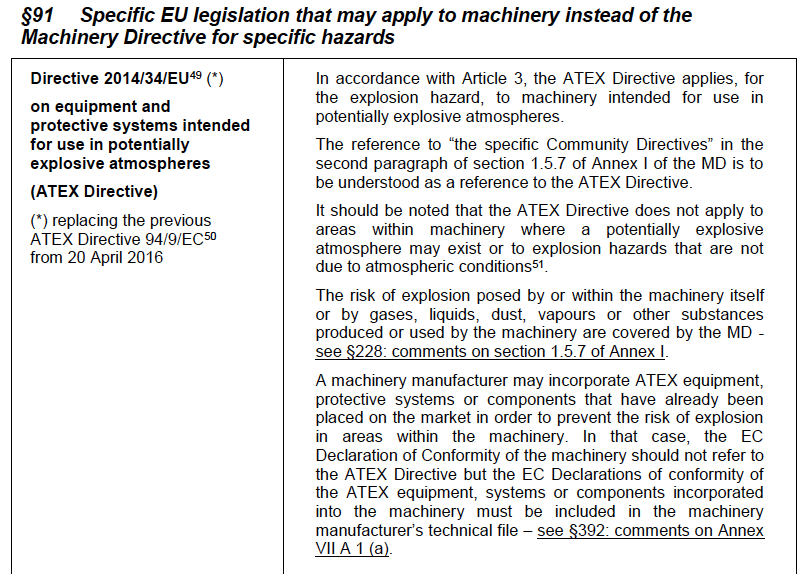
§228 Explosion
The requirement set out in the first paragraph of section 1.5.7 (§228) applies to the risks of explosion due to the operation of the machinery itself or to materials or substances used or produced by the machinery.
Explosions may occur if the combustion of certain concentrations of flammable substances such as gases, vapours, mists or dust in air is triggered by an ignition source of sufficient energy. Explosions involve a very rapid self-sustaining propagation of the combustion reaction with a build-up of high pressure. The damage caused by explosions to persons and property is due to the violent emission of flames, thermal radiation, pressure waves, flying debris and hazardous substances. The severity of the
potential damage depends mainly on the quantity of explosive mixture present and its nature. The principles that apply to the prevention of the risk of explosion are similar to those for the prevention of the risk of fire. Preventing the risk of explosion involves a combination of:
– avoiding the accumulation of explosive mixtures in areas in or around the machinery by avoiding flammable materials and substances or by permanently maintaining their concentration in the air at values outside the lower or upper explosion limits;
– avoiding the presence of ignition sources in hazardous areas;
– reducing the concentration of oxygen in hazardous areas (insofar as this does not give rise to an additional risk for persons).
Where the risk of explosion cannot be completely prevented, complementary protective measures shall be taken to limit the consequences of an explosion. Such measures include, for example, explosion-resistant design, fitting explosion relief devices (vents), fitting automatic explosion detection and suppression systems or devices to prevent the propagation of flame and explosion.
General specifications for assessing, preventing and protecting against the risk of explosion are given in standard EN 1127-1. According to the secondparagraph of section 1.5.7, machinery intended for use in or in
relation to a potentially explosive atmosphere is subject to the provisions of the ATEX Directive179 – see §91: comments on Article 3. The concept of a potentially explosive atmosphere is explained in the Guidelines on the application of the ATEX Directive. Machinery subject to the ATEX Directive is subject to specific marking requirements – see §251: comments on the third paragraph of section 1.7.3.
Although the ATEX Directive is not applicable as such to explosion risks generated within the machinery itself, equipment complying with the requirements of the ATEX Directive must be fitted in areas of machinery where there is a risk of accumulation of a potentially explosive atmosphere.
Non.electrical explosion protection shall be a headache if you try to work on it after URS. It shall be considered as mandatory from early scratch.
Keep up good work!
Arpad





